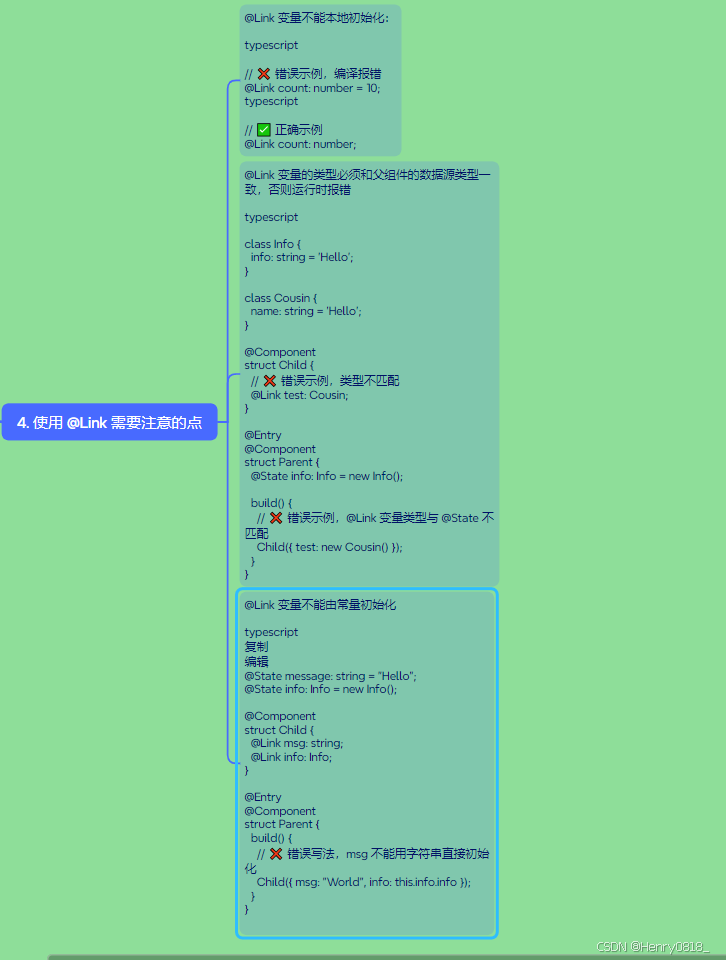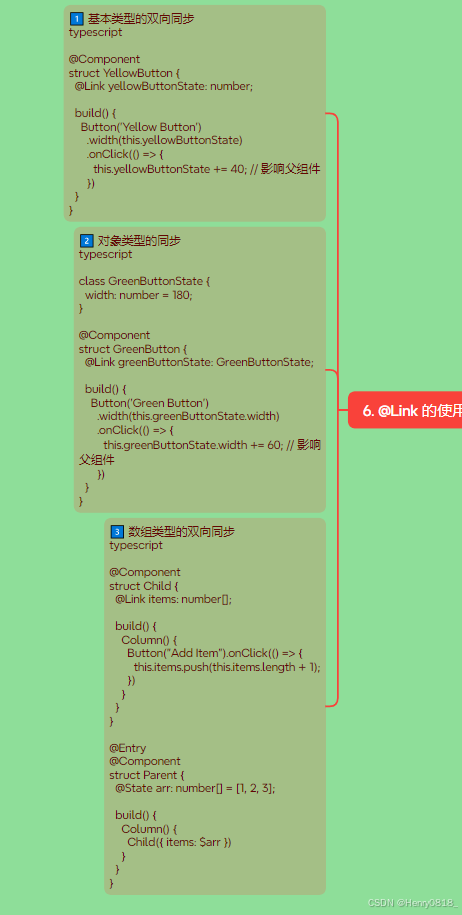-
1. @Link 的作用
-
双向数据绑定:子组件中的变量(被 @Link 修饰)会与父组件的数据源(通常是 @State 变量)保持同步。 变化感知:当数据发生变化时,父组件和子组件都能感知并触发 UI 更新。
-

-
2. 与 @State 的关系
-
@State:在父组件中定义,管理组件内部状态,支持响应式更新。 @Link:在子组件中使用,引用父组件的 @State 变量,实现双向数据同步。
-
@Entry @Component struct ParentComponent { @State parentCount: number = 0; build() { Column() { Button("Increase Parent Count") .onClick(() => { this.parentCount += 1; }) ChildComponent({ childCount: this.parentCount }) } } } @Component struct ChildComponent { @Link childCount: number; build() { Column() { Button("Increase Child Count") .onClick(() => { this.childCount += 1; // 影响父组件的 parentCount }) Text(`Child Count: ${this.childCount}`) } } }
@Entry @Component struct ParentComponent { @State parentCount: number = 0; build() { Column() { Button("Increase Parent Count") .onClick(() => { this.parentCount += 1; }) ChildComponent({ childCount: this.parentCount }) } } } @Component struct ChildComponent { @Link childCount: number; build() { Column() { Button("Increase Child Count") .onClick(() => { this.childCount += 1; // 影响父组件的 parentCount }) Text(`Child Count: ${this.childCount}`) } } } -
点击子组件的按钮,父组件的 parentCount 也会同步增加。 点击父组件的按钮,子组件的 childCount 也会同步增加。
-
-
3. @Link 变量的类型
-
支持的数据类型: 基础类型:string、number、boolean、enum 对象类型:Object、class 集合类型(API 11+):Map、Set 特殊类型(ArkUI 定义):Length、ResourceStr、ResourceColor 不支持 any 类型 支持联合类型(API 11+):string | number、ClassA | null 等
-

-
4. 使用 @Link 需要注意的点
-
@Link 变量不能本地初始化: typescript // ❌ 错误示例,编译报错 @Link count: number = 10; typescript // ✅ 正确示例 @Link count: number;
-
@Link 变量的类型必须和父组件的数据源类型一致,否则运行时报错 typescript class Info { info: string = 'Hello'; } class Cousin { name: string = 'Hello'; } @Component struct Child { // ❌ 错误示例,类型不匹配 @Link test: Cousin; } @Entry @Component struct Parent { @State info: Info = new Info(); build() { // ❌ 错误示例,@Link 变量类型与 @State 不匹配 Child({ test: new Cousin() }); } }
-
-
@Link 变量不能由常量初始化 typescript 复制 编辑 @State message: string = "Hello"; @State info: Info = new Info(); @Component struct Child { @Link msg: string; @Link info: Info; } @Entry @Component struct Parent { build() { // ❌ 错误写法,msg 不能用字符串直接初始化 Child({ msg: "World", info: this.info.info }); } }

-
5. 观察数据变化
-

-
@Entry @Component struct Parent { @State selectedDate: Date = new Date('2021-08-08'); build() { Column() { DateComponent({ selectedDate: this.selectedDate }) } } } @Component struct DateComponent { @Link selectedDate: Date; build() { Column() { Button("Increase Year") .onClick(() => { this.selectedDate.setFullYear(this.selectedDate.getFullYear() + 1); }) } } }6. @Link 的使用场景
-
 x`
x`
-
1️⃣ 基本类型的双向同步
typescript
@Component
struct YellowButton {
@Link yellowButtonState: number;
build() {
Button('Yellow Button')
.width(this.yellowButtonState)
.onClick(() => {
this.yellowButtonState += 40; // 影响父组件
})
}
}
2️⃣ 对象类型的同步
typescript
class GreenButtonState {
width: number = 180;
}
@Component
struct GreenButton {
@Link greenButtonState: GreenButtonState;
build() {
Button('Green Button')
.width(this.greenButtonState.width)
.onClick(() => {
this.greenButtonState.width += 60; // 影响父组件
})
}
}
3️⃣ 数组类型的双向同步
typescript
@Component
struct Child {
@Link items: number[];
build() {
Column() {
Button("Add Item").onClick(() => {
this.items.push(this.items.length + 1);
})
}
}
}
@Entry
@Component
struct Parent {
@State arr: number[] = [1, 2, 3];
build() {
Column() {
Child({ items: $arr })
}
}
}
-
7. @Link 的生命周期
-
@Link 变量的生命周期与其所在组件一致。 当父组件销毁时,子组件中的 @Link 变量也会随之销毁。 UI 更新流程: 父组件的 @State 变量更新 子组件的 @Link 变量同步变化 UI 自动刷新
-
-
8. @Link 的局限性
-
不能在 @Entry 组件中使用 不能装饰 Function 类型的变量 不能用于常量初始化 必须与父组件的状态变量类型一致
-
-
总结
-
@Link = 父子组件之间的双向绑定桥梁 主要用于子组件同步父组件的状态 支持多种数据类型,数组、对象、Map、Set 变化可被感知,自动刷新 UI 但有一定的使用限制
-























 1万+
1万+

 被折叠的 条评论
为什么被折叠?
被折叠的 条评论
为什么被折叠?








